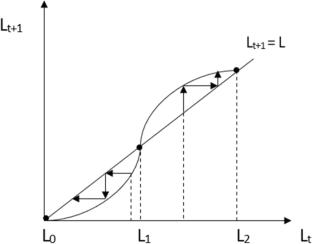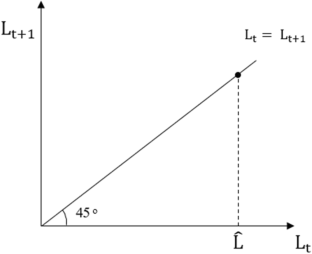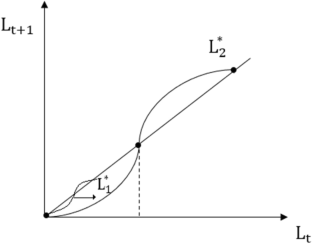Abstract
How can governments attract entrepreneurs and their businesses? The view that new business creation grows with the optimal level of government investment remains appealing to policymakers. In contrast with this active approach, we build a model where governments may adopt a passive approach to stimulating business creation. The insights from this model suggest new business creation depends positively on factors beyond government investments—attracting high-skilled migrants to the region and lower property prices, taxes, and fines on firms in the informal sector. These findings suggest whether entrepreneurs generate business creation in the region does not only depend on government investments. It also depends on location and skilled migration. Our model also provides methodological implications—the relationship between government investments and new business creation is endogenously determined, so unless adjustments are made, econometric estimates will be biased and inconsistent. We conclude with policy and managerial implications.
Plain English Summary
Governments can attract entrepreneurs and their businesses by offering incentives such as lower property prices, taxes, and fines on firms in the informal sector, as well as by encouraging skilled migration to the region. Thus, a policy implication is that the government can create a favorable environment for business creation as opposed to solely relying on government investments.



Similar content being viewed by others
Data Availability
Data sharing is not applicable to this article as no new data were created or analyzed in this study.
Notes
Good Jobs First. (2022). Subsidy tracker. https://www.goodjobsfirst.org/subsidy-tracker
Greenstone and Moretti, 2003 studied the location of million-dollar business investments announced in the 1982–1993 period and provided an economic analysis of the value the local region of attracting large firms by weighing the benefits of employment and property value gains against the costs of incentive packages.
See Packard and Bylund (2018) for criticism on the focus of this type of entrepreneurship.
Although we discuss government infrastructure investments, government investments can be quite broad. For example, according to Lerner (2010), Singapore implemented specific government policies such as: “The provision of public funds for venture investors seeking to locate in the city-state; Subsidies for firms in targeted technologies; Encouragement of potential entrepreneurs and mentoring for fledgling ventures; Subsidies for leading biotechnology researchers to move their laboratories to Singapore; Awards for failed entrepreneurs (with a desire to encourage risk-taking).”.
Although Bennett (2019b) excludes projects in the power, communication, and railroad sectors from private infrastructure investments, there are historical examples of private companies investing in these sectors. For example, James J. Hill built the Great Northern Railway from St. Paul to Seattle with no US government aid (Folsom, 1991).
An example of the type of infrastructure investments that we have in mind is a government investment in rural high-speed broadband (Cumming and Johan 2010), which is quite different than some other types of investment, like neighborhood beautification, in terms of how it affects entrepreneurship. Because the focus here is on job creation and destruction, we ignore the effects of government policy on low growth entrepreneurship, which deserves to be studied in a framework where its contributions to society are accounted appropriately, as advocated by Welter et al. (2017).
The Q in the model is a parameter that represents the spatial restrictions in the regional economy due to distance, negative agglomeration externalities, and/or regulations. The Q is assumed exogenous, being determined by regional idiosyncrasies like topography and land use regulations, which are typically disconnected from the government levels or entities that provide business incentives.
We assume decreasing returns in the public-good investment technology, such that x > 1, as in Acemoglu (2005).
The reverse is also likely true—business creation tends to attract more workers and immigrants. However, in our model, M is exogenously given, so the only causality possible in our model is from immigration to business creation. We thank one anonymous reviewer for pointing this out.
Even if infrastructure investments do not affect business creation directly, they might have an indirect effect through property prices, taxes, and immigration. As such, a possible extension of the model is to integrate G into these functions. However, this exercise would make exogenous variables like property prices, taxes, and immigration endogenous, so we miss their important impact in the model and in the policy prescriptions. Moreover, this extension changes the model entirely, yielding a different analysis and results. Thus, we leave this extension for future research.
References
Abdel-Rahman, H. M. (1988). Product differentiation, monopolistic competition and city size. Regional Science and Urban Economics, 18, 69–86. https://doi.org/10.1016/0166-0462(88)90006-3
Acemoglu, D. (2005). Politics and economics in weak and strong states. Journal of Monetary Economics, Political Economy and Macroeconomics, 52, 1199–1226. https://doi.org/10.1016/j.jmoneco.2005.05.001
Ács, Z. J., Autio, E., & Szerb, L. (2014). National systems of entrepreneurship: Measurement issues and policy implications. Research Policy, 43, 476–494. https://doi.org/10.1016/j.respol.2013.08.016
Acs, Z. J., & Mueller, P. (2008). Employment effects of business dynamics: Mice, gazelles and elephants. Small Business Economics, 30, 85–100. https://doi.org/10.1007/s11187-007-9052-3
Acs, Z., & Szerb, L. (2007). Entrepreneurship, economic growth and public policy. Small Business Economics, 28, 109–122. https://doi.org/10.1007/s11187-006-9012-3
Acs, Z., Åstebro, T., Audretsch, D., & Robinson, D. T. (2016). Public policy to promote entrepreneurship: A call to arms. Small Business Economics, 47, 35–51. https://doi.org/10.1007/s11187-016-9712-2
Acs, Z. (2006). How is entrepreneurship good for economic growth? innovations 1, 97–107. https://doi.org/10.1162/itgg.2006.1.1.97
Andersson, P., & Wadensjö, E. (2007). Do the unemployed become successful entrepreneurs? International Journal of Manpower, 28, 604–626. https://doi.org/10.1108/01437720710830070
Aparicio, S., Audretsch, D., & Urbano, D. (2021). Why is export-oriented entrepreneurship more prevalent in some countries than others? Contextual antecedents and economic consequences. Journal of World Business, 56, 101177. https://doi.org/10.1016/j.jwb.2020.101177
Arauzo-Carod, J.-M., & Viladecans-Marsal, E. (2009). Industrial location at the intra-metropolitan level: The role of agglomeration economies. Regional Studies, 43, 545–558. https://doi.org/10.1080/00343400701874172
Audretsch, D. B., Keilbach, M. C., & Lehmann, E. E. (2006). Entrepreneurship and economic growth. Oxford University Press.
Audretsch, D. B., Heger, D., & Veith, T. (2015). Infrastructure and entrepreneurship. Small Business Economics, 44, 219–230. https://doi.org/10.1007/s11187-014-9600-6
Audretsch, D. (2003). Entrepreneurship policy and the strategic management of places, in: Hart, D.M. (Ed.), The emergence of entrepreneurship policy: Governance, start-ups, and growth in the U.S. Knowledge Economy. UK: Cambridge University Press.
Autio, E., & Rannikko, H. (2016). Retaining winners: Can policy boost high-growth entrepreneurship? Research Policy, 45, 42–55. https://doi.org/10.1016/j.respol.2015.06.002
Bandyopadhyay, S., & Pinto, S. M. (2017). Unauthorized immigration and fiscal competition. European Economic Review, 92, 283–305. https://doi.org/10.1016/j.euroecorev.2016.12.010
Barrios, S., Görg, H., & Strobl, E. (2006). Multinationals’ location choice, agglomeration economies, and public incentives. International Regional Science Review, 29, 81–107. https://doi.org/10.1177/0160017605281516
Bennett, D. L. (2019). Infrastructure investments and entrepreneurial dynamism in the US. Journal of Business Venturing, 34, 105907. https://doi.org/10.1016/j.jbusvent.2018.10.005
Bennett, D. L. (2019). Local economic freedom and creative destruction in America. Small Business Economics. https://doi.org/10.1007/s11187-019-00222-0
Bennett, D. L. (2021). Local institutional heterogeneity & firm dynamism: Decomposing the metropolitan economic freedom index. Small Business Economics, 57, 493–511. https://doi.org/10.1007/s11187-020-00322-2
Bjørnskov, C., & Foss, N. J. (2016). Institutions, entrepreneurship, and economic growth: What do we know and what do we still need to know? The Academy of Management Perspectives, 30, 292–315. https://doi.org/10.5465/amp.2015.0135
Block, J. H., Fisch, C. O., & van Praag, M. (2018). Quantity and quality of jobs by entrepreneurial firms. Oxford Review of Economic Policy, 34, 565–583. https://doi.org/10.1093/oxrep/gry016
Bosma, N., Hill, S., Ionescu-Somers, A., Kelley, D., Levie, J., & Tarnawa, A., (2020). Global entrepreneurship monitor 2019/2020 global report. Global Entrepreneurship Research Association, London Business School, 5–7. UK.
Boudreaux, C., & Nikolaev, B. (2019). Capital is not enough: Opportunity entrepreneurship and formal institutions. Small Business Economics, 53, 709–738. https://doi.org/10.1007/s11187-018-0068-7
Boudreaux, C., Nikolaev, B., & Holcombe, R. (2018). Corruption and destructive entrepreneurship. Small Business Economics, 51, 181–202. https://doi.org/10.1007/s11187-017-9927-x
Boudreaux, C., Nikolaev, B. N., & Klein, P. (2019). Socio-cognitive traits and entrepreneurship: The moderating role of economic institutions. Journal of Business Venturing, 34, 178–196.
Boudreaux, C. J., Bennett, D. L., Lucas, D. S., & Nikolaev, B. N. (2022). Taking mental models seriously: Institutions, entrepreneurship, and the mediating role of socio-cognitive traits. Small Business Economics. https://doi.org/10.1007/s11187-022-00712-8
Boudreaux, C., Coats, R.M., & Davis, E.H., (2012). The dark side of state competition for foreign direct investment: That which is seen and that which is not seen. Southern Business & Economic Journal, 35(1), 35–52.
Bucovetsky, S. (2005). Public input competition. Journal of Public Economics, 89, 1763–1787. https://doi.org/10.1016/j.jpubeco.2004.07.001
Buffart, M., Croidieu, G., Kim, P. H., & Bowman, R. (2020). Even winners need to learn: How government entrepreneurship programs can support innovative ventures. Research Policy, Innovative start-ups and policy initiatives, 49, 104052. https://doi.org/10.1016/j.respol.2020.104052
Bylund, P. L., (2016). The seen, the unseen, and the unrealized: How regulations affect our everyday lives. Lexington Books.
Coad, A., & Srhoj, S. (2020). Catching gazelles with a lasso: Big data techniques for the prediction of high-growth firms. Small Business Economics, 55, 541–565. https://doi.org/10.1007/s11187-019-00203-3
Coomes, P. A., Fernandez, J., & Gohmann, S. F. (2013). The rate of proprietorship among metropolitan areas: The impact of the local economic environment and capital resources. Entrepreneurship Theory and Practice, 37, 745–770. https://doi.org/10.1111/j.1540-6520.2012.00511.x
Crozet, M., Mayer, T., & Mucchielli, J.-L. (2004). How do firms agglomerate? A study of FDI in France. Regional Science and Urban Economics, 34, 27–54. https://doi.org/10.1016/S0166-0462(03)00010-3
Cumming, D., & Johan, S. (2010). The differential impact of the internet on spurring regional entrepreneurship. Entrepreneurship Theory and Practice, 34, 857–884. https://doi.org/10.1111/j.1540-6520.2009.00348.x
Cumming, D., Johan, S., & MacIntosh, J. G. (2017). A drop in an empty pond: Canadian public policy towards venture capital. Econ Polit Ind, 44, 103–117. https://doi.org/10.1007/s40812-016-0063-4
Cumming, D., Johan, S., & Zhang, Y. (2018). Public policy towards entrepreneurial finance: Spillovers and the scale-up gap. Oxford Review of Economic Policy, 34, 652–675. https://doi.org/10.1093/oxrep/gry012
Dahl, M. S., & Sorenson, O. (2012). Home sweet home: Entrepreneurs’ location choices and the performance of their ventures. Management Science, 58, 1059–1071. https://doi.org/10.1287/mnsc.1110.1476
De Soto, H. (2000). The mystery of capital: Why capitalism triumphs in the west and fails everywhere else. Basic Books
Devereux, M. P., Griffith, R., & Simpson, H. (2007). Firm location decisions, regional grants and agglomeration externalities. Journal of Public Economics, 91, 413–435. https://doi.org/10.1016/j.jpubeco.2006.12.002
Faria, J. R. (2016). Location clusters, FDI and local entrepreneurs: Consistent public policy. Journal of the Knowledge Economy, 7, 858–868. https://doi.org/10.1007/s13132-015-0272-5
Faria, J. R., Prado, M., & Ferreira, J. J. (2021). Informality, infrastructure investments, and new firms’ creation: The location strategy. Journal of the Knowledge Economy. https://doi.org/10.1007/s13132-021-00727-8
Feldman, M., Francis, J., & Bercovitz, J. (2005). Creating a cluster while building a firm: Entrepreneurs and the formation of industrial clusters. Regional Studies, 39, 129–141. https://doi.org/10.1080/0034340052000320888
Folsom, B. W. (1991). The myth of the robber barons: A new look at the rise of big business in America. USA: Young Americas Foundation
Fredriksson, A. (2020). One stop shops for public services: Evidence from citizen service centers in Brazil. Journal of Policy Analysis and Management, 39, 1133–1165. https://doi.org/10.1002/pam.22255
Fritsch, M. (2008). How does new business formation affect regional development? Introduction to the special issue. Small Business Economics, 30, 1–14. https://doi.org/10.1007/s11187-007-9057-y
Galbraith, C. S. (1985). High-technology location and development: The case of Orange County. California Management Review, 28, 98–109. https://doi.org/10.2307/41165172
Glaeser, E. L., Rosenthal, S. S., & Strange, W. C. (2010). Urban economics and entrepreneurship. Journal of Urban Economics, Special Issue: Cities and Entrepreneurship, 67, 1–14. https://doi.org/10.1016/j.jue.2009.10.005
Goodman, J.P, Meany, J.W, & Pate, L.E. (1992). The government as entrepreneur: Industrial development and the creation of new ventures. In: Sexton, D.L., & Kasarda, J.D. (Eds.), The State of the Art of Entrepreneurship. Boston: PWS_Kent
Greenstone, M., & Moretti, E., (2003). Bidding for industrial plants: Does winning a “million dollar plant” increase welfare? (Working Paper No. 9844), Working Paper Series. National Bureau of Economic Research. https://doi.org/10.3386/w9844
Grimes, S. (2000). Rural areas in the information society: Diminishing distance or increasing learning capacity? Journal of Rural Studies, 16, 13–21. https://doi.org/10.1016/S0743-0167(99)00027-3
Gwartney, J., Lawson, R., & Hall, J., (2019). Economic freedom of the world 2019 annual report. The Fraser Institute. https://www.fraserinstitute.org/studies/economic-freedom-of-the-world-2019-annual-report
Hayter, R. (1997). The dynamics of industrial location: The factory, the firm and the production system. Wiley.
Henrekson, M., & Stenkula, M. (2010). Entrepreneurship and public policy. In: Acs, Z.J., & Audretsch, D.B. (Eds.) Handbook of Entrepreneurship Research (pp. 595–637). USA: Springer
Henrekson, M., & Johansson, D. (2010). Gazelles as job creators: A survey and interpretation of the evidence. Small Business Economics, 35, 227–244. https://doi.org/10.1007/s11187-009-9172-z
Henrekson, M., & Sanandaji, T. (2011). The interaction of entrepreneurship and institutions. Journal of Institutional Economics, 7, 47–75. https://doi.org/10.1017/S1744137410000342
Holcombe, R. G. (1998). Entrepreneurship and economic growth. Quarterly Journal of Austrian Economics, 1, 45–62.
Holtz-Eakin, D. (2000). Public policy toward entrepreneurship. Small Business Economics, 15, 283–291. https://doi.org/10.1023/A:1011153921409
Lee, Y. S. (2018). Government guaranteed small business loans and regional growth. Journal of Business Venturing, 33, 70–83. https://doi.org/10.1016/j.jbusvent.2017.11.001
Lerner, J. (2010). The future of public efforts to boost entrepreneurship and venture capital. Small Business Economics, 35, 255–264. https://doi.org/10.1007/s11187-010-9298-z
Lucas, D. S., & Boudreaux, C. (2020). National regulation, state-level policy, and local job creation in the United States: A multilevel perspective. Research Policy, 49, 103952. https://doi.org/10.1016/j.respol.2020.103952
Luo, L., Ma, X., Makino, S., & Shinkle, G. A. (2020). Cluster status and new venture creation. Journal of Business Venturing, 35, 105985. https://doi.org/10.1016/j.jbusvent.2019.105985
Mason, C., & Brown, R. (2013). Creating good public policy to support high-growth firms. Small Business Economics, 40, 211–225. https://doi.org/10.1007/s11187-011-9369-9
Mazzucato, M. (2018). Mission-oriented innovation policies: Challenges and opportunities. Industrial and Corporate Change, 27, 803–815. https://doi.org/10.1093/icc/dty034
Mazzucato, M. (2015). Entrepreneurial state: Debunking public vs. private sector myths. USA: Anthem Press
Mendicino, C., & Prado, M. (2014). Heterogeneous firms and the impact of government policy on welfare and informality. Economics Letters, 124, 151–156. https://doi.org/10.1016/j.econlet.2014.04.018
Michael, S. C., & Pearce, J. A. (2009). The need for innovation as a rationale for government involvement in entrepreneurship. Entrepreneurship & Regional Development, 21, 285–302. https://doi.org/10.1080/08985620802279999
Minniti, M. (2008). The role of government policy on entrepreneurial activity: Productive, unproductive, or destructive? Entrepreneurship Theory and Practice, 32, 779–790. https://doi.org/10.1111/j.1540-6520.2008.00255.x
Morgan, H. M., Sui, S., & Baum, M. (2018). Are SMEs with immigrant owners exceptional exporters? Journal of Business Venturing, 33, 241–260. https://doi.org/10.1016/j.jbusvent.2017.12.003
Murphy, K. M., Shleifer, A., & Vishny, R. W. (1991). The allocation of talent: Implications for growth. The Quarterly Journal of Economics, 106, 503–530. https://doi.org/10.2307/2937945
Nikolaev, B., Boudreaux, C., & Palich, L. E. (2018). Cross-country determinants of early stage necessity and opportunity-motivated entrepreneurship: Accounting for model uncertainty. Journal of Small Business Management. https://doi.org/10.1111/jsbm.12400
Obaji, N. O., & Olugu, M. U. (2014). The role of government policy in entrepreneurship development. Science Journal of Business and Management, 2, 109–115.
Ogura, L. (2018). Informality and exogenous regulations in regional economies. Economics Bulletin, 38, 892–900.
Ouwersloot, H., & Rietveld, P. (2000). The geography of R&D: Tobit analysis and a Bayesian approach to mapping R&D activities in the Netherlands. Environment and Planning A, 32, 1673–1688. https://doi.org/10.1068/a3336
Packard, M. D., & Bylund, P. L. (2018). On the relationship between inequality and entrepreneurship. Strategic Entrepreneurship Journal, 12, 3–22. https://doi.org/10.1002/sej.1270
Padilla-Pérez, R., & Gaudin, Y. (2014). Science, technology and innovation policies in small and developing economies: The case of Central America. Research Policy, 43, 749–759. https://doi.org/10.1016/j.respol.2013.10.011
Parker, S. C. (2018). The economics of entrepreneurship. Cambridge University Press.
Parker, S. C. (2020). Editorial: On submitting economics articles to JBV. Journal of Business Venturing, 35, 106018. https://doi.org/10.1016/j.jbusvent.2020.106018
Popper, K. R. (1934). Logik der Forschung. Springer, Hutchinson & Co.
Prado, M. (2011). Government policy in the formal and informal sectors. European Economic Review, 55, 1120–1136. https://doi.org/10.1016/j.euroecorev.2011.04.010
Sabat, W., & Pilewicz, T. (2019). Business location decision: The behavioural aspect in empirical research. Journal of Management and Financial Sciences, 99–109. https://doi.org/10.33119/JMFS.2019.37.6
Say, J. B. (1828). Cours complet d’économie politique pratique. Paris: Chez Rapilly, Libraire
Schumpeter, J. A. (1934). The theory of economic development: An inquiry into profits, capital, credit, interest, and the business cycle. Transaction Publishers
Shane, S. (2009). Why encouraging more people to become entrepreneurs is bad public policy. Small Business Economics, 33, 141–149. https://doi.org/10.1007/s11187-009-9215-5
Slattery, C. (2018). Bidding for firms: Subsidy competition in the US. SSRN: https://ssrn.com/abstract=3250356.
Sorenson, O. (2018). Social networks and the geography of entrepreneurship. Small Business Economics, 51, 527–537. https://doi.org/10.1007/s11187-018-0076-7
Taylor, L. (1992). Infrastructural competition among jurisdictions. Journal of Public Economics, 49, 241–259. https://doi.org/10.1016/0047-2727(92)90022-8
Thurik, R., & Wennekers, S. (2004). Entrepreneurship, small business and economic growth. Journal of Small Business and Enterprise Development, 11, 140–149. https://doi.org/10.1108/14626000410519173
Urbano, D., Aparicio, S., & Audretsch, D. (2019). Twenty-five years of research on institutions, entrepreneurship, and economic growth: What has been learned? Small Business Economics, 53, 21–49. https://doi.org/10.1007/s11187-018-0038-0
Van De Ven, H. (1993). The development of an infrastructure for entrepreneurship. Journal of Business Venturing, Special Theoretical Issue, 8, 211–230. https://doi.org/10.1016/0883-9026(93)90028-4
van Praag, C. M., & Versloot, P. H. (2007). What is the value of entrepreneurship? A review of recent research. Small Business Economics, 29, 351–382. https://doi.org/10.1007/s11187-007-9074-x
Welter, F., Baker, T., Audretsch, D. B., & Gartner, W. B. (2017). Everyday entrepreneurship—A call for entrepreneurship research to embrace entrepreneurial diversity. Entrepreneurship Theory and Practice, 41, 311–321. https://doi.org/10.1111/etap.12258
Wennberg, K., & Sandström, C. (Eds.) (2022). Questioning the entrepreneurial state: Status-quo, pitfalls, and the need for credible innovation policy. Springer Nature. https://doi.org/10.1007/978-3-030-94273-1
Wennekers, S., & Thurik, R. (1999). Linking entrepreneurship and economic growth. Small Business Economics, 13, 27–56. https://doi.org/10.1023/A:1008063200484
Author information
Authors and Affiliations
Corresponding author
Additional information
Publisher's Note
Springer Nature remains neutral with regard to jurisdictional claims in published maps and institutional affiliations.
Supplementary Information
Below is the link to the electronic supplementary material.
Rights and permissions
Springer Nature or its licensor (e.g. a society or other partner) holds exclusive rights to this article under a publishing agreement with the author(s) or other rightsholder(s); author self-archiving of the accepted manuscript version of this article is solely governed by the terms of such publishing agreement and applicable law.
About this article
Cite this article
Faria, J.R., Ogura, L., Prado, M. et al. Government investments and entrepreneurship. Small Bus Econ 61, 1657–1670 (2023). https://doi.org/10.1007/s11187-023-00743-9
Accepted:
Published:
Issue Date:
DOI: https://doi.org/10.1007/s11187-023-00743-9




